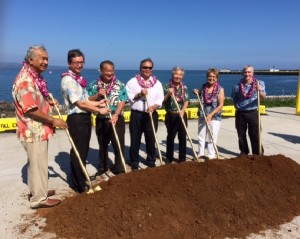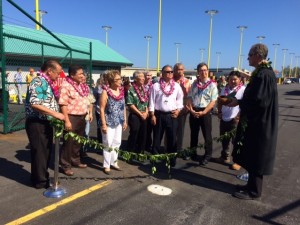HDOT celebrates Pier 4 project with groundbreaking and dedication/blessing ceremony at Hilo Harbor
Posted on Jan 15, 2016 in Main, NewsHILO – The Hawaii Department of Transportation (HDOT), Harbors Division, celebrated the Pier 4 Project at Hilo Harbor with a groundbreaking and dedication/blessing ceremony earlier today. The project consists of multiple phases: dredging and construction of the Pier 4 Inter-Island Cargo Terminal, construction of the Inter-Island Cargo Terminal Facility–Container Yard, and Kumau Street Entrance Improvements.
HDOT will begin work on the final phase of the project, the Pier 4 Inter-Island Cargo Terminal. This phase involves the creation of a 602 linear foot reinforced concrete pier with associated site work that will be located to the west of the existing Pier 3.
The completed Inter-Island Cargo Terminal Facility–Container Yard component of the project reconstructed a portion of the existing container yard and built a new adjacent container yard with a comfort station, lighting, and utilities. This phase generated an additional 4 acres to be used for cargo operations, amounting to approximately 10 acres total.
In order to relieve traffic congestion and enhance safety, the completed Kumau Street Entrance Improvements widened the street from a 2-lane roadway to a 4-lane roadway and provided intersection improvements at Kalanianaole Street. Improvements include new asphaltic concrete pavement, concrete sidewalks, curbs, gutters, drainage system, water main, and additional street lighting at the Kalanianaole Street Intersection.
“The construction of Pier 4 at Hilo Harbor will create a dedicated operating area for inter-island cargo operations which will relieve the issues that the harbor currently experiences,” said HDOT Director Ford Fuchigami. “Transporting provisions to Hawaii County will become more efficient, thus promoting economic and social growth.”
The estimated total cost for the project is $68.5 million. Work on the final phase is anticipated to be completed by July of 2017.
Currently, inter-island cargo operations are conducted at Pier 2, a pier constructed in the 1920s that functions with restrictions. Due to space limitations, operations at Pier 2 require space from Pier 1 and Pier 3. This creates the intermingling of cargo and cruise ship operations. The utilization of Pier 2 is also compromised when liquid-bulk operations occur at Pier 3. Creating Pier 4, a larger pier with a dedicated area, will improve safety and efficiency by separating the cargo and passenger operations. It will replace the aging Pier 2 and be able to support new container handling equipment and vessels.

State executives and dignitaries gather to celebrate the groundbreaking of the Pier 4 Inter-Island Cargo Terminal, the final phase of the Pier 4 project at Hilo Harbor.
From left to right: Senator Gilbert Kahele; Roy Catalani, Vice President, Young Brothers, Limited; Darrell Young, HDOT Deputy Director Harbors Division; Wil Okabe, Governor David Ige’s Representative; Representative Clift Tsuji; Senator Lorraine Inouye; Rick Heltzel, Hawaii Harbors Constructors JV

Kahu Brian Welsh leads the untying of the maile lei, signifying the official completion of the Kumau Street Entrance Improvements.
From left to right: Darrell Young, HDOT Deputy Director Harbors Division; Jade Butay, HDOT Deputy Director Administration; Senator Lorraine Inouye; Representative Clift Tsuji; Wil Okabe, Governor David Ige’s Representative; Senator Gilbert Kahele; Roy Catalani, Vice President, Young Brothers, Limited; Ivan Kabei, Hawaiian Dredging Construction Company; Kahu Brian Welsh
###
